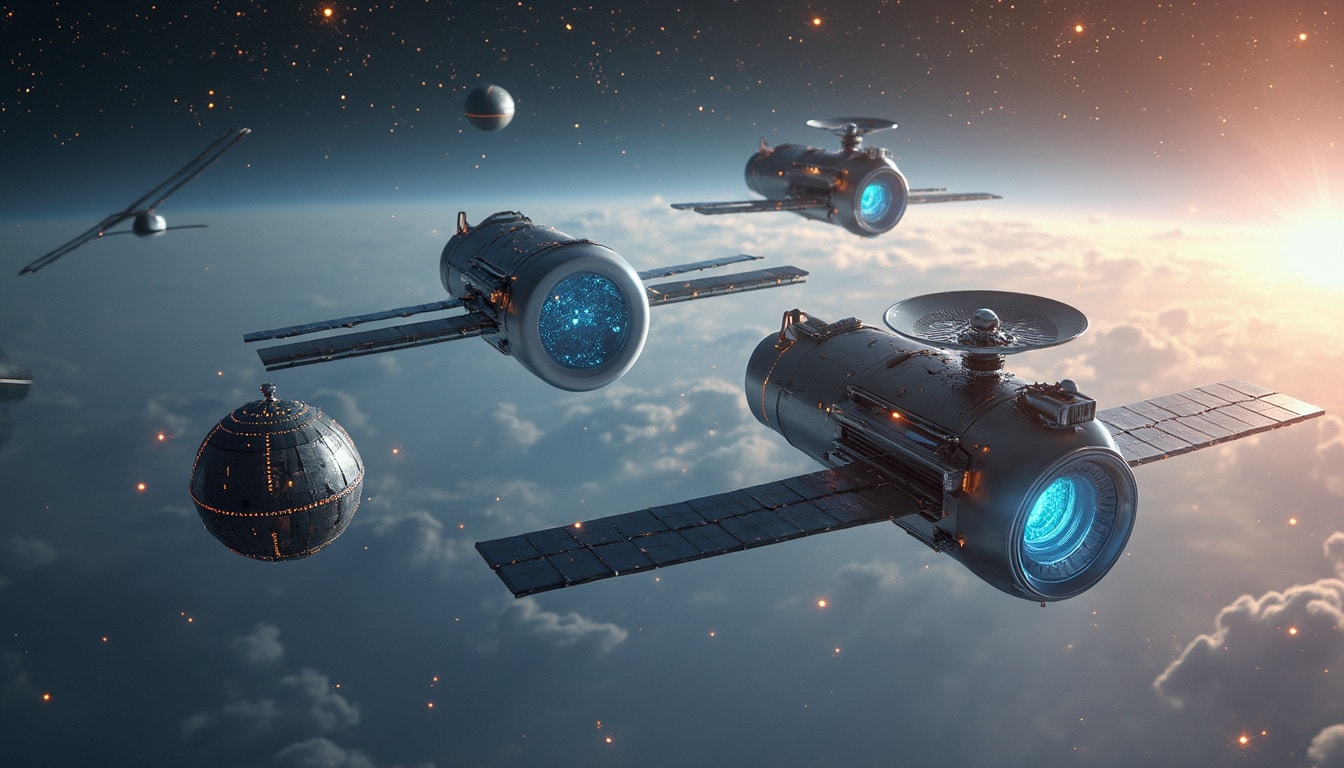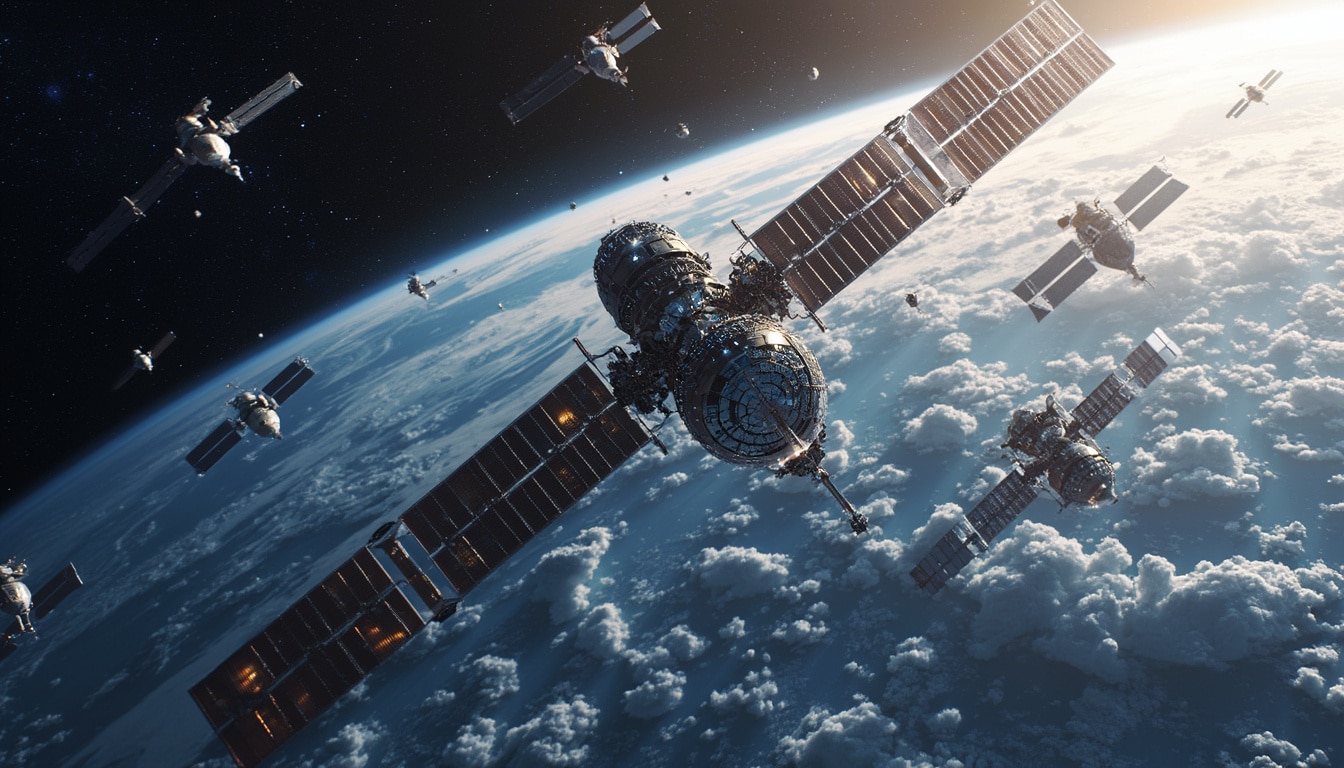The rise of satellites in low Earth orbit is not just a testament to humanity’s technological advancements but also heralds a new era in space exploration and coordination. With the increasing number of satellite operators and missions, the need for effective space traffic management has never been more critical. In this context, NASA’s Starling spacecraft swarm and SpaceX’s Starlink constellation have emerged as front-runners in testing solutions to enhance coordination and manage the growing workloads in space.
This dynamic collaboration serves as a pioneering effort towards achieving seamless communication and operation among diverse satellite networks. The recent mission known as Starling 1.5 pushed the boundaries of autonomous systems by allowing satellites to not only track but also respond to potential conjunction events effectively. By focusing on the ballet of movements between satellites, this initiative promises to reduce the potential dangers posed by orbital debris and ensure that space communication systems work in harmony.
Understanding Space Traffic Coordination
In the vastness of space, the complex dance of satellites requires precise coordination. With countless objects orbiting the Earth at varying altitudes, space traffic management systems have been put in place to monitor these trajectories. The fundamental goal is to alert operators of potential conjunctions, situations where two objects diverge into close proximity, which could lead to disastrous collisions.

The Complexity of Present Coordination Systems
Presently, various methodologies exist for tracking the movement of satellites. Operators receive alerts when another object surpasses their specified risk threshold for a close approach. This threshold can vary significantly, with operators managing alerts based on probabilities ranging from 1 in 10,000 to as low as 1 in 1,000,000. However, managing these parameters involves significant manual coordination, requiring lengthy negotiations via phone and email. Situations arise where operators may receive alerts for various reasons, causing confusion and inefficiencies.
Moreover, once a potential conjunction is detected, operators must collectively communicate to devise a mitigation plan. This process can be time-consuming, sometimes taking several days to finalize maneuvers. For missions focused on critical observations, this is less than ideal. The emergence of rapid response capabilities is essential for timely adjustments, which could unlock opportunities for new observations, especially during critical events like natural disasters.
Starling’s Innovative Approach to Coordination
The advent of NASA’s Starling program marked a significant shift in how spacecraft could autonomously interact and coordinate in real-time. Originally designed to demonstrate autonomous planning and execution of orbital maneuvers, the Starling mission now extends to collaborating efficiently with SpaceX’s Starlink satellites. This represents a giant leap towards automating not just operations but also the responsibility of maneuvering when necessary.
Interestingly, this collaboration has resulted in SpaceX adopting a screening service allowing satellite operators to submit their proposed trajectories and quickly receive feedback on any conjunction risks. This systematic approach enables operators to accept responsibility for avoidance, streamlining what has historically been a cumbersome process.
During the Starling 1.5 initiative, NASA successfully tested these capabilities, showcasing how its satellites could plan maneuvers and coordinate autonomously during potential conjunctions with Starlink satellites. The experiment validated the effectiveness of this screening service, which is anticipated to significantly ameliorate space communication and reduce collision risks between satellites.
The Broader Impact of NASA and SpaceX Collaboration
The partnership between NASA’s Starling program and SpaceX’s Starlink constellation signifies a critical milestone in the realm of autonomous space travel and convoying technologies. With an ever-increasing number of spacecraft in orbit, the implications of improved coordination extend far beyond efficiency metrics; they touch on safety, disaster response, and innovations in astronautics.
Expanding the Horizons of Satellite Operations
The rapid deployment of satellites for various purposes, from communication to earth observation, has placed unprecedented demands on existing coordination frameworks. As the operations scale up, a flexible and robust system becomes indispensable. Starling 1.5 serves as a case study in proving that effective coordination not only increases safety but can also enhance data sampling and operational efficiency.
Imagining a future where autonomous coordination is the norm raises interesting questions about the evolution of satellite networks. The ability to send automated responses and adjustments among satellites promises to revolutionize missions that require real-time data — for instance, natural disaster tracking and environmental assessments. This adaptability in planning maneuvers may allow satellites to shift orbits rapidly to capture unique phenomena, resulting in richer data acquisition and analysis.
Paving the Way for Future Technologies
Ultimately, the focus on systemic improvements in space traffic management via partnerships like those between NASA and SpaceX signals the dawn of new technologies. The consolidation and enhancement of such collaborations allow for a shared understanding of risks and responsibilities, where each operator can focus more on their mission-specific objectives without getting bogged down in administrative challenges.
Moreover, this progress is a clear indicator of how automated systems could render orbital debris a manageable issue. With better coordination and real-time response capabilities, the risks associated with conjunction events could effectively be minimized. Moving forward, further advanced collaborative initiatives can fuel technology development that will ease space operations.
The Role of Autonomous Systems in Future Missions
The landscape of space exploration is rapidly evolving, heavily influenced by advancements in automation and artificial intelligence. Satellites capable of autonomous maneuvers present significant opportunities in terms of operational flexibility. As missions expand not only in scope but in complexity, the need for responsive satellite networks grows.

Augmenting Real-Time Data Collection Capabilities
Enhanced autonomy in satellite operation will empower missions to adapt quickly to emerging situations. With capabilities to reroute at speed, these systems can provide direct insights during critical events such as natural disasters or climate phenomena. The redundancy allowed by collaborative autonomous networks could represent a leap forward in ensuring comprehensive data collection.
If a swarm of satellites can coordinate on the fly, they can adapt their trajectories swiftly, allowing for optimized vantage points of observation. This kind of real-time responsiveness is crucial when dealing with the unpredictability of nature; having a few hours to reposition could mean the difference between capturing essential data and missing crucial observational windows.
Enabling New Modes of Collaboration Between Operators
The continuing relationship between NASA’s Starling and SpaceX’s Starlink plainly illustrates the future of multi-operator collaboration. By developing standards for interaction and communication among diverse satellite operators, it sets the groundwork for cooperative systems that transcend individual missions. Such frameworks could promote the establishment of shared protocols that might eventually form the bedrock of the next generation of space communication systems.
This collaborative spirit fosters a culture of innovation, where ideas can flourish and technological breakthroughs are commonplace. The benefits to operators are myriad, from reduced collision risks to improved data integrity, and these systems emphasize the importance of teamwork in space.
A Future Built on Collaborative Space Exploration
The narrative of space travel and exploration is dramatically reshaping with each successful mission. With NASA’s Starling and SpaceX’s Starlink paving the way for enhanced coordination, a robust future beckons where space missions become seamless and efficient due to autonomous systems.
Supplementary data from successful missions like these not only drives progress but also crafts an inspiring vision for the future of aerospace and beyond. As new technologies evolve and collaboration increases among operators, the potential for discovery in the cosmos expands.
| Key Developments | Partnership Impact | Future Implications |
|---|---|---|
| Starling 1.5 Testing | Validated autonomous maneuver coordination with SpaceX | Reduced collision risks in LEO |
| Screening Service Implementation | Fast, efficient risk assessment for satellite operators | Expanded operational flexibility and rapid response |
| Real-time Data Collection | Faster adjustments to capture critical observations | Enhanced disaster response capabilities and research quality |




Leave a Reply